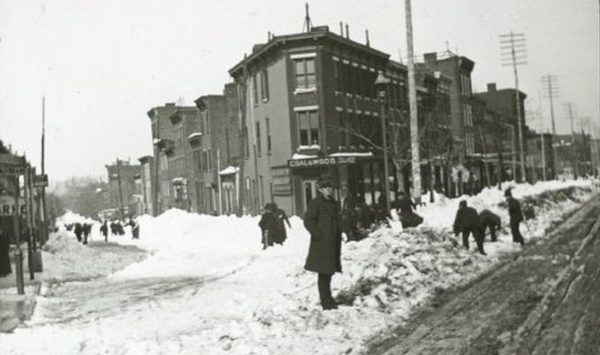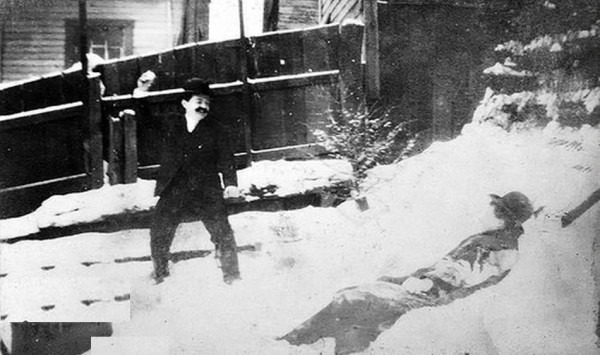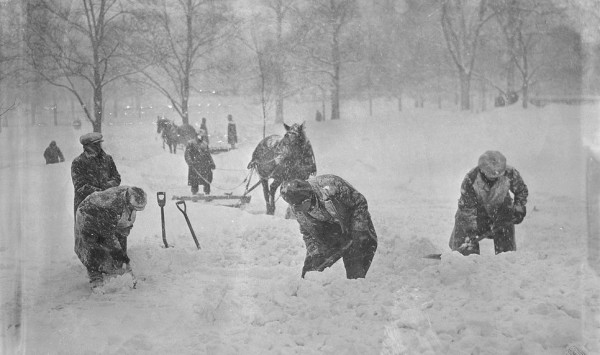SNOW DAY ON BERGEN & FLATBUSH (1888)

******************************************************************************************************************************** Brownstone Detectives investigates the history of our clients’ homes. The story you are about to read was composed from research conducted in the course of one of those investigations. ******************************************************************************************************************************** Although today was merely a dusting in comparison to the Blizzard of 1888, it gives us an opportunity to look back on what the aftermath of a real snowstorm looked like. In the inset black & white photograph, we see men clearing snow outside of a coal & wood store after the blizzard at the corner of Flatbush Avenue and Bergen Street. We’ve included a Google Maps view of what that corner looks like today. The Coal & Wood shop is now a Gino’s Pizza at 218 Flatbush Avenue. Follow @BrownstoneDetec Share ———————————————————————————————————————– The Brownstone Detectives Brownstone Detectives is a property research agency. Our mission is to research, document, and save the histories of our clients’ historic properties. From this research, we produce our celebrated House History Books. Each book is fully cited, featuring detailed narratives and colorful graphics, and is designed to bring the history of any house to life. Contact us today to begin discovering the history of your home.
BLOOD ON THE SNOWBALL (1888)

As the snow piled up during the Blizzard of 1888, Brooklynites began to experience countless fights. Snowball fights, that is. Most were lighthearted and fun, romps in the snow bringing joy and relief from the endless shoveling and the stress of everyday life with the white stuff. But sometimes these snowball fights turned ugly, exposing the more unsavory side of Brooklynites. They showed how quickly a snowball fight could evolve from a joyful game into mayhem-filled terror. Two cases, in particular, made the pages of the Brooklyn Daily Eagle during the week of the historic blizzard. One involved a razor. The second involved a gun. THE RAZOR The day after the “Great White Hurricane” struck Brooklyn, Vincent Ciemon was a very tired man. He had reason to be after a long day of shoveling snow following the first full day of the Blizzard of 1888. He had just been employed by the Long Island Railroad Company as that organization needed day laborers to help dig out their engines in the city and beyond. On his way home around 5 p.m., to the apartment where he lived with his family on East New York Avenue in Brownsville, Ciemon had just reached Rockaway Avenue “when a snowball struck him in the back.” Ciemon, identified by the Brooklyn Daily Eagle in the story as “The Italian,” had only a hundred or so feet before he arrived home and so, tired as he was, he did not even turn around to challenge his tormentors. […]
HAPPY “SURGE PRICING” NEW YEAR! (1867)

A blinding snowstorm welcomed in the New Year in the City of Brooklyn in 1867. From “daylight and until early noon” the snow was “falling, falling fast,” as “thousands of juveniles commenced the year industriously, by earning their New Year’s gifts, in sweeping and shoveling the snow off the sidewalks. ” In spite of the snowfall, the Brooklyn Daily Eagle reported that “there never were so many open houses and never so many callers.” SURGE PRICING IN 1867 “Callers, as a general thing, didn’t mind the snow much, while to the keepers of livery stables, the appearance of the morning air, filled with its myriad snow flakes, became a vision, exceeding in its richness the fabled mines of Golconda.” In a word, these taxi drivers were seeing dollar signs within the Brooklyn snowfall. And the harder the snow fell, the more money their sleighs would be bringing in. “They knew that the light wagons for which they had been paid in advance, would not be taken out, and for sleighs they could charge such prices as they chose.” Like a modern-day taxi service – upon which rested no fixed rates – these 19th century taxi hacks would begin to set new prices on their services, determining – based upon the wiles of the consumer and the availability of the taxi driver – how much their service was worth on the new snowclad market. “Only think of it, fifty dollars for two or three hours use of a vehicle of that […]